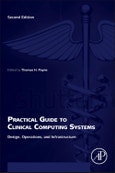Although informatics trainees and practitioners who assume operational computing roles in their organization may have reasonably advanced understanding of theoretical informatics, many are unfamiliar with the practical topics - such as downtime procedures, interface engines, user support, JCAHO compliance, and budgets - which will become the mainstay of their working lives.
Practical Guide to Clinical Computing Systems 2nd edition helps prepare these individuals for the electronic age of health care delivery. It is also designed for those who migrate into clinical computing operations roles from within their health care organization. A new group of people interested in this book are those preparing for Clinical Informatics board certification in the US.
The work provides particular differentiation from the popular first edition in four areas:
- 40% more content detailing the many practical aspects of clinical informatics.
- Addresses the specific needs of the Clinical Informatics board certification course - for which it is presently recommended by the ABPM
- Focus on new tech paradigms including cloud computing and concurrency - for this rapidly changing field.
- Focuses on the practical aspects of operating clinical computing systems in medical centers rather than abstruse theory
- Provides deepened and broadened authorship with a global panel of contributors providing new wisdom and new perspectives - reflecting inclusion of the first edition on the clinical informatics study guide materials
- Presents a practical treatment of workday but often unfamiliar issues - downtime procedures, interface engines, user support, JCAHO compliance, and budgets
Table of Contents
1. Introduction and Overview of Clinical Computing Systems within a Medical Center2. Architecture of Clinical Computing Systems
3. Creating and Supporting Interfaces
4. Infrastructure and Security
5. From Project to Operations: Planning to Avoid Problems
6. Implementation and Transition to Operations
7. Troubleshooting: What Can Go Wrong and How to Fix It
8. Working with the User
9. Health Information Management and the EMR
10. Legal Issues in Medical Records/Health Information Management
11. Working with Organizational Leadership
12. Careers in Biomedical Informatics and Clinical Computing








